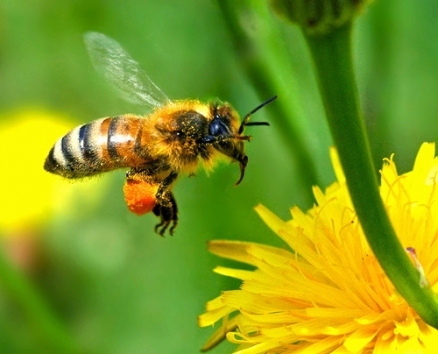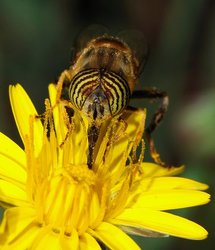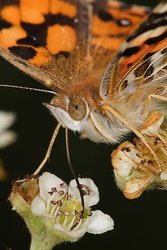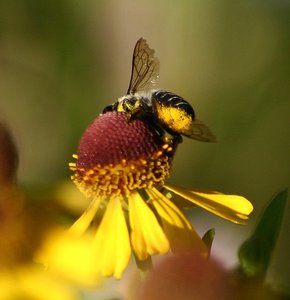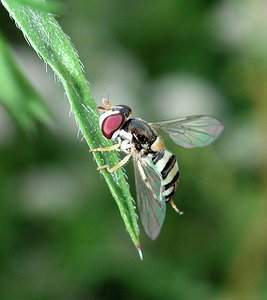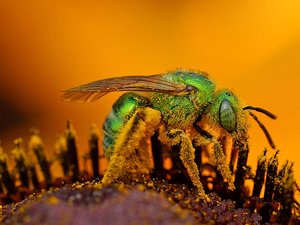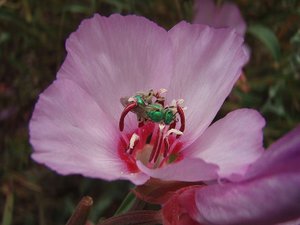Pollinator
A pollinator is the biotic agent (vector) that moves pollen from the male anthers of a flower to the female stigma of a flower to accomplish fertilization or syngamy of the female gamete in the ovule of the flower by the male gamete from the pollen grain. Though the terms are sometimes confused, a pollinator is different from a pollenizer, which is a plant that is a source of pollen for the pollination process.
Contents
Background
Plants fall into pollination syndromes that reflect the type of pollinator being attracted. These are characteristics such as: overall flower size, the depth and width of the corolla, the color (including patterns called nectar guides that are visible only in ultraviolet light), the scent, amount of nectar, composition of nectar, etc.[1] For example, birds visit red flowers with long narrow tubes and lots of nectar, but are not as strongly attracted to wide flowers with little nectar and copious pollen, which are more attractive to beetles. When these characteristics are experimentally modified (altering color, size, orientation), pollinator visitation may decline[2],[3].
Types of pollinators
Bees
The most recognized pollinators are the various species of bees, which are plainly adapted to pollination. Bees typically are fuzzy and carry an electrostatic charge. Both features help pollen grains adhere to their bodies, but they also have specialized pollen-carrying structures; in most bees, this takes the form of a structure known as the scopa, which is on the hind legs of most bees, and/or the lower abdomen (e.g., of megachilid bees), made up of thick, plumose setae. Honey bees, bumblebees, and their relatives do not have a scopa, but the hind leg is modified into a structure called the corbicula (also known as the "pollen basket"). Most bees gather nectar, a concentrated energy source, and pollen, which is high protein food, to nurture their young, and inadvertently transfer some among the flowers as they are working. Euglossine bees pollinate orchids, but these are male bees collecting floral scents rather than females gathering nectar or pollen. Female orchid bees act as pollinators, but of flowers other than orchids. Eusocial bees such as honey bees need an abundant and steady source of pollen to multiply.
Honey bees
Honey bees travel from flower to flower, collecting nectar (later converted to honey), and pollen grains. The bee collects the pollen by rubbing against the anthers. The pollen collects on the hind legs, in a structure referred to as a "pollen basket". As the bee flies from flower to flower, some of the pollen grains are transferred onto the stigma of other flowers. Nectar provides the energy for bee nutrition; pollen provides the protein. When bees are rearing large quantities of brood (beekeepers say hives are "building"), bees deliberately gather pollen to meet the nutritional needs of the brood. A honey bee that is deliberately gathering pollen is up to ten times more efficient as a pollinator than one that is primarily gathering nectar and only unintentionally transferring pollen.
Good pollination management seeks to have bees in a "building" state during the bloom period of the crop, thus requiring them to gather pollen, and making them more efficient pollinators. Thus the management techniques of a beekeeper providing pollination services are different from, and somewhat incompatible with, those of a beekeeper who is trying to produce honey.
Millions of hives of honey bees are contracted out as pollinators by beekeepers, and honey bees are by far the most important commercial pollinating agents, but many other kinds of pollinators, from bluebottle flies, to bumblebees, orchard mason bees, and leaf cutter bees are cultured and sold for managed pollination.
Other species of bees differ in various details of their behavior and pollen-gathering habits, and it should be remembered that honey bees are not native to the Western Hemisphere; all pollination of native plants in the Americas has been historically performed by various native bees.
Other insects
Lepidoptera (butterflies and moths) also pollinate to a small degree.[4] They are not major pollinators of our food crops, but various moths are important for some wildflowers, or other commercial crops such as tobacco.
Many other insects accomplish pollination. Wasps (esp. Sphecidae and Vespidae), bombyliid flies and syrphid flies are important pollinators of some plants. Beetles, midges, and even thrips or ants can sometimes pollinate flowers. Green bottle or carrion flies are important for some flowers, usually ones that exude a fetid odor. Some male Bactrocera fruit flies are exclusive pollinators of some wild Bulbophyllum orchids that have a specific chemical attractant present in their floral fragrance[5][6]. Some Diptera (flies) may be the main pollinators in higher elevations of mountains whereas Bombus species are the only pollinators among Apoidea in alpine regions at timberline and beyond. Other insect orders are rarely pollinators, and then typically only accidentally (e.g., Hemiptera such as Anthocoridae, Miridae)
Vertebrates
Bats are important pollinators of some tropical flowers. Birds, particularly hummingbirds, honeyeaters and sunbirds also accomplish much pollination, especially of deep-throated flowers. Other vertebrates, such as monkeys, lemurs, possums, rodents and lizards[7] have been recorded pollinating some plants.
Humans can be pollinators, as many gardeners have discovered that they must hand pollinate garden vegetables, whether because of pollinator decline (as has been occurring in parts of the U.S. since the mid-20th century) or simply to keep a strain genetically pure. This can involve using a small brush or cotton swab to move pollen, or to simply tap or shake tomato blossoms to release the pollen for the self pollinating flowers. Tomato blossoms are self fertile, but (with the exception of potato-leaf varieties) have the pollen inside the anther, and the flower requires shaking to release the pollen through pores. This can be done by wind, by humans, or by a sonicating bee (one that vibrates its wing muscles while perched on the flower), such as a bumblebee. Sonicating bees are extremely efficient pollinators of tomatoes, and colonies of bumblebees are quickly replacing humans as the primary pollinators for greenhouse tomatoes.
Gallery
Note: This article uses material from the Wikipedia article Pollinator that was accessed on November 30, 2008. The Author(s) and Topic Editor(s) associated with this article may have significantly modified the content derived from Wikipedia with original content or with content drawn from other sources. All content from Wikipedia has been reviewed and approved by those Author(s) and Topic Editor(s), and is subject to the same peer review process as other content in the EoE. The current version of the Wikipedia article may differ from the version that existed on the date of access. This article is licensed under the GNU Free Documentation License 1.2. See the EoE’s Policy on the Use of Content from Wikipedia for more information.
References
Further Reading
- Sprengel, C K. Das entdeckte Geheimnis der Natur im Bau und in der Befruchtung der Blumen. Berlin, 1793.
- Fægri, K, and L. van der Pijl. The Principles of Pollination Ecology. New York: Pergamon Press, 1979.
- Percival, Mary S. Floral Biology. New York: Pergamon Press, 1965.
- Real, Leslie. Pollination Biology. New York: Academic Press, 1983.
- List of crop plants pollinated by bees
- Pollination
- Pollination syndromes
- Self-pollination
- New "Pollinator Garden Wheel" from the National Academies provides information on pollination and tips on building a pollinator-friendly garden.
- Pollinator & Visitor Image Database (for Orchidaceae)
- Pollinator Partnership
Citation
, W. (2014). Pollinator. Retrieved from http://editors.eol.org/eoearth/wiki/pollinator- ↑ Fægri, K. and L. van der Pijl. 1979. The principles of pollination ecology. Oxford: Pergamon.
- ↑ Fulton M, Hodges SA. 1999. Floral isolation between Aquilegia formosa and A. pubescens. Proceedings of the Royal Society of London, Series B 266: 2247–2252.
- ↑ Hodges SA, Whittall JB, Fulton M, Yang JY. 2002. Genetics of floral traits influencing reproductive isolation between Aquilegia formosa and A. pubescens. American Naturalist 159: S51–S60.
- ↑ <a class="external free" href="http://www.fs.fed.us/wildflowers/pollinators/butterflies.shtml" rel="nofollow" title="http://www.fs.fed.us/wildflowers/pollinators/butterflies.shtml">http://www.fs.fed.us/wildflowers/pollinators/butterflies.shtml</a>
- ↑ Tan, K.H.& R. Nishida. 2005. Synomone or Kairomone? - Bulbophyllum apertum (Orchidaceae) flower releases raspberry ketone to attract Bactrocera fruit flies. Journal of Chemical Ecology. 31(3): 509-519.
- ↑ Tan, K.H.& R. Nishida. 2007. Zingerone in the floral synomone of Bulbophyllum baileyi (Orchidaceae) attracts Bactrocera fruit flies during pollination. Biochemical Systematics & Ecology 35: 334-341.
- ↑ Olesen, J. M. & A. Valido. 2003. Lizards as pollinators and seed dispersers: an island phenomenon. Trends in Ecology and Evolution 18: 177-181.
